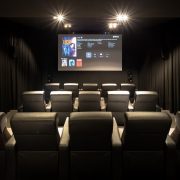What Defines An Immersive Home Theatre System
For the inexperienced, the difference between watching a movie and being immersed in a truly great home theater experience may seem minor, but the reality is far different. From a physical sense, the term home theater can be broadly defined. In one home it might be a 16-seat dedicated room with a 100-inch drop-down screen, but more likely it’s a multi-use media room with an AV system that handles music playback, TV, gaming and movie nights. Regardless of where it’s set-up or how many seats it has, the definition of an exceptional home theater experience is the same whether you’re in a villa or an apartment.
The end goal of any home theater should be to create an environment where the sensory content is so realistic, and rendered so accurately that it allows you to suspend your disbelief for a couple hours and accept what’s happening onscreen as reality. It could be a blockbuster movie, a big game, a TV series, or a first-person shooter video game, but the ability to truly immerse yourself in the experience is at the heart of a great home theater.
MORE ONSCREEN ACTION
So what does it take to create this sensation of suspended reality? The first thing most people think about is a TV or projector. The most important factor in choosing your video solution should be to find something big enough to fully occupy your field of vision. The more onscreen action you see, the less you’ll be distracted, and the more dialed into the content you’ll feel. Industry guidelines for 1080p HDTVs recommend a viewing distance of about 1.5-2.5 x the screen diagonal. For example, the optimal viewing distance for a 70” HDTV is about 8.5-14.5 feet. The enhanced resolution of 4K reduces that to 1-1.5 x the screen diagonal – so you can go bigger and sit closer for an even more immersive experience!
If you’re considering a front projector, it’s essential to have a room that can be fully darkened like a dedicated home theater room. If you want to use a projector in a living/family room where ambient light cannot be fully controlled, choose a model with sufficient brightness (lumens) and contrast ratio to prevent image wash-out in a lighted room.
VISUALLY AND SONICALLY APPEALING
Video is important, of course, but when it comes down to exciting your senses, three-quarters of the emotional impact, the dynamics, the energy and the engagement comes from the sound. A great home theater needs to convince you both visually and sonically that the on-screen experience is really happening.
For starters, the system needs to accurately cover the entire audible bandwidth at lifelike playback levels, from the deepest subterranean bass to the highest treble. All dialogue, every sound effect and all music needs to be accurately reproduced. Each speaker channel has a different purpose and all are equally important and need to work together seamlessly to deliver a convincing experience.
All of the speakers should convey a continuous and evolving field of sonic vision. You should be able to precisely detect the points in space where sounds are coming from and it should correspond exactly with the onscreen action. Also, each speaker should be sonically matched with similar voicing and tone. As the sound effects pan across multiple channels, the sonic character of the sound will not change and the listener then perceives the entire sound field as a single source – this is called the “precedence effect.”
Center AUDIO CHANNEL
The center channel is perhaps the most undervalued audio channel in a home theater set-up. The primary function of the center channel is to handle the hugely important role of dialogue playback, because typically in movies and TV, when a character is speaking, you see them onscreen. Center channel speakers have an incredibly difficult job, because they have to create the illusion that sound is coming right from a person’s lips, and failure to do so takes away from the realism of your home theater experience. But center speakers are not just for dialogue. They also serve as the sonic bridge between front main speakers and ensure seamless panning effect and continuity of sound across the entire front stage.
MULTI-DIMENSIONAL SOUND FIELD
The various surround channels (side, rear, overhead) need to create a multi-dimensional sound field that engulfs the listener. It might be a conversation happening behind you, the crack of a twig from an unseen stalker, an overhead helicopter or the faint pitter-patter of raindrops. Surround speakers create the illusion the listener is in the center of what is unfolding onscreen, which is critical for the suspension of disbelief.
THE SOUNDSTAGE
The subwoofer also has a critical role in the home theater system – it needs to realistically convey the full dynamic impact and pressure of the demanding low-frequency effects (LFE) channel in action, thriller and sci-fi movies. But a great subwoofer needs to be distinct too – anchoring the entire soundstage and accurately reproducing the music score and subtle deep background effects used for mood and creating tension.
The subwoofer also handles the deepest bass from the various loudspeaker channels (particularly the center and surround channels), allowing them to focus on reproducing the midrange and high frequencies for a more precise and articulate presentation. Routing the speaker channel bass to the subwoofer also conserves amplifier power in the AV receiver, which enhances overall system dynamics.
To create a convincing and realistic home theater experience, your entire audio system needs to accurately reproduce all voices, instruments, musical scores and sound effects and place them in their intended location in time and space in order to truly immerse and transport the viewer.



